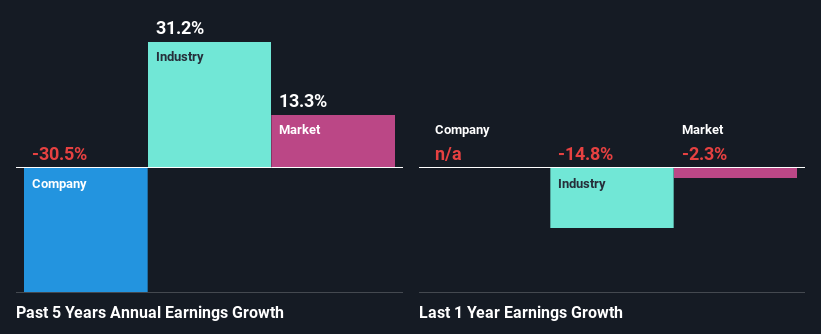Intel (NASDAQ:INTC) has had a rough three months with its share price down 26%. We, however decided to study the company’s financials to determine if they have got anything to do with the price decline. Stock prices are usually driven by a company’s financial performance over the long term, and therefore we decided to pay more attention to the company’s financial performance. Specifically, we decided to study Intel’s ROE in this article.
ROE or return on equity is a useful tool to assess how effectively a company can generate returns on the investment it received from its shareholders. In short, ROE shows the profit each dollar generates with respect to its shareholder investments.
Check out our latest analysis for Intel
How Is ROE Calculated?
ROE can be calculated by using the formula:
Return on Equity = Net Profit (from continuing operations) ÷ Shareholders’ Equity
So, based on the above formula, the ROE for Intel is:
3.6% = US$4.0b ÷ US$111b (Based on the trailing twelve months to March 2024).
The ‘return’ refers to a company’s earnings over the last year. One way to conceptualize this is that for each $1 of shareholders’ capital it has, the company made $0.04 in profit.
Why Is ROE Important For Earnings Growth?
Thus far, we have learned that ROE measures how efficiently a company is generating its profits. Depending on how much of these profits the company reinvests or “retains”, and how effectively it does so, we are then able to assess a company’s earnings growth potential. Generally speaking, other things being equal, firms with a high return on equity and profit retention, have a higher growth rate than firms that don’t share these attributes.
Intel’s Earnings Growth And 3.6% ROE
As you can see, Intel’s ROE looks pretty weak. Not just that, even compared to the industry average of 15%, the company’s ROE is entirely unremarkable. Therefore, it might not be wrong to say that the five year net income decline of 30% seen by Intel was possibly a result of it having a lower ROE. We believe that there also might be other aspects that are negatively influencing the company’s earnings prospects. For instance, the company has a very high payout ratio, or is faced with competitive pressures.
So, as a next step, we compared Intel’s performance against the industry and were disappointed to discover that while the company has been shrinking its earnings, the industry has been growing its earnings at a rate of 31% over the last few years.
The basis for attaching value to a company is, to a great extent, tied to its earnings growth. It’s important for an investor to know whether the market has priced in the company’s expected earnings growth (or decline). By doing so, they will have an idea if the stock is headed into clear blue waters or if swampy waters await. If you’re wondering about Intel’s’s valuation, check out this gauge of its price-to-earnings ratio, as compared to its industry.
Is Intel Making Efficient Use Of Its Profits?
Looking at its three-year median payout ratio of 29% (or a retention ratio of 71%) which is pretty normal, Intel’s declining earnings is rather baffling as one would expect to see a fair bit of growth when a company is retaining a good portion of its profits. So there could be some other explanations in that regard. For instance, the company’s business may be deteriorating.
Moreover, Intel has been paying dividends for at least ten years or more suggesting that management must have perceived that the shareholders prefer dividends over earnings growth. Existing analyst estimates suggest that the company’s future payout ratio is expected to drop to 19% over the next three years. As a result, the expected drop in Intel’s payout ratio explains the anticipated rise in the company’s future ROE to 8.7%, over the same period.
Summary
In total, we’re a bit ambivalent about Intel’s performance. While the company does have a high rate of reinvestment, the low ROE means that all that reinvestment is not reaping any benefit to its investors, and moreover, its having a negative impact on the earnings growth. That being so, the latest industry analyst forecasts show that the analysts are expecting to see a huge improvement in the company’s earnings growth rate. To know more about the latest analysts predictions for the company, check out this visualization of analyst forecasts for the company.
Have feedback on this article? Concerned about the content? Get in touch with us directly. Alternatively, email editorial-team (at) simplywallst.com.
This article by Simply Wall St is general in nature. We provide commentary based on historical data and analyst forecasts only using an unbiased methodology and our articles are not intended to be financial advice. It does not constitute a recommendation to buy or sell any stock, and does not take account of your objectives, or your financial situation. We aim to bring you long-term focused analysis driven by fundamental data. Note that our analysis may not factor in the latest price-sensitive company announcements or qualitative material. Simply Wall St has no position in any stocks mentioned.
Have feedback on this article? Concerned about the content? Get in touch with us directly. Alternatively, email [email protected]
Source Agencies


